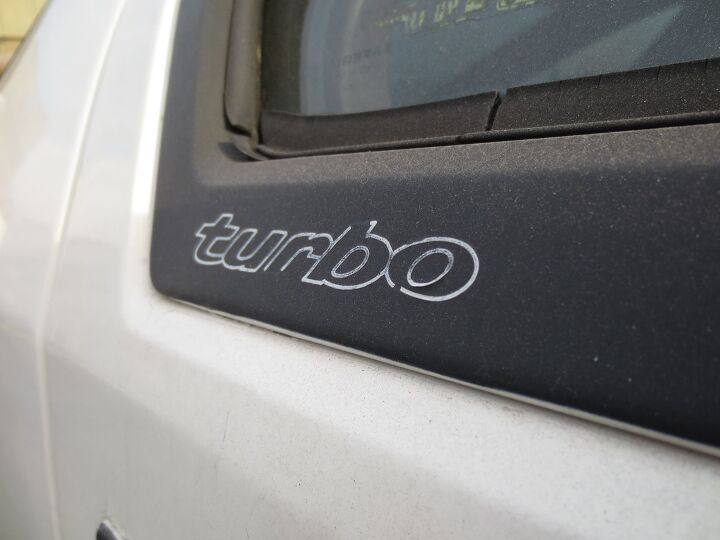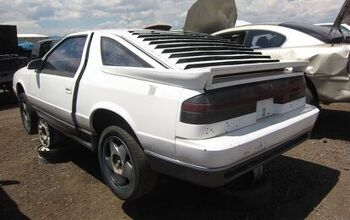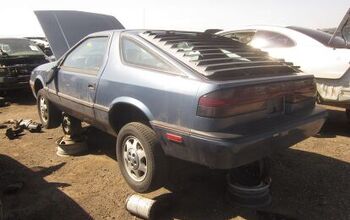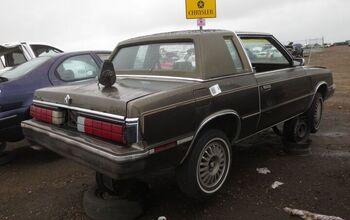Junkyard Find: 1985 Dodge Daytona Turbo

After the near-miraculous success of the K platform dug Chrysler out of the pit of its near-bankruptcy and controversial government bailout (no, not that bailout, the earlier one), Lee Iacocca led the company to produce a bewildering number of vehicles based on the K. Chrysler had some sporty machinery based on the Simca-derived Omnirizon (not to mention some hot rebadged Mitsubishis), but the Dodge Daytona and its Chrysler Laser sibling were the bread-and-butter factory hot rods of the 1980s and a bit beyond.
Here’s an ’85 I spotted at a now-defunct Los Angeles-area yard a while back.
So far in this series, we have admired this ’87 Daytona Shelby Z, this ’88 Daytona Turbo, this ’90 Daytona Turbo, this ’90 Daytona ES Turbo, this ’92 Daytona IROC R/T (yes, there was a Daytona IROC, trivia fans), plus this optioned-up ’85 Chrysler Laser XE.
Turbocharging was a magical thing in the middle 1980s, one of the major factors that enabled the American automotive landscape to emerge from the Malaise Era. Yes, this engine made fewer than 150 turbo-laggy horses, torque steer was horrendous (by current standards), and K-Car build quality made for iffy long-term reliability at best … but the Daytona/Laser Turbo felt pretty quick at the time.
Well, maybe it wasn’t so quick with the slushbox, but the TURBO badging gave the car’s owner bragging rights.
In the car business, product comes first!
This rugged-looking 1980s fella knew that it was Morning In America when he witnessed that new Daytona drive off the billboard.
If you bought the Shelby Turbo Z version, the attractive big-haired 1980s babes would be lured right out of roadside cafes and into your car. Proven scientific fact. You can’t see her pastel-colored leg warmers in this ad, but you know she owned many pairs.
[Images: © 2016 Murilee Martin/The Truth About Cars]

Murilee Martin is the pen name of Phil Greden, a writer who has lived in Minnesota, California, Georgia and (now) Colorado. He has toiled at copywriting, technical writing, junkmail writing, fiction writing and now automotive writing. He has owned many terrible vehicles and some good ones. He spends a great deal of time in self-service junkyards. These days, he writes for publications including Autoweek, Autoblog, Hagerty, The Truth About Cars and Capital One.
More by Murilee Martin
Latest Car Reviews
Read moreLatest Product Reviews
Read moreRecent Comments
- W Conrad I'm not afraid of them, but they aren't needed for everyone or everywhere. Long haul and highway driving sure, but in the city, nope.
- Jalop1991 In a manner similar to PHEV being the correct answer, I declare RPVs to be the correct answer here.We're doing it with certain aircraft; why not with cars on the ground, using hardware and tools like Telsa's "FSD" or GM's "SuperCruise" as the base?Take the local Uber driver out of the car, and put him in a professional centralized environment from where he drives me around. The system and the individual car can have awareness as well as gates, but he's responsible for the driving.Put the tech into my car, and let me buy it as needed. I need someone else to drive me home; hit the button and voila, I've hired a driver for the moment. I don't want to drive 11 hours to my vacation spot; hire the remote pilot for that. When I get there, I have my car and he's still at his normal location, piloting cars for other people.The system would allow for driver rest period, like what's required for truckers, so I might end up with multiple people driving me to the coast. I don't care. And they don't have to be physically with me, therefore they can be way cheaper.Charge taxi-type per-mile rates. For long drives, offer per-trip rates. Offer subscriptions, including miles/hours. Whatever.(And for grins, dress the remote pilots all as Johnnie.)Start this out with big rigs. Take the trucker away from the long haul driving, and let him be there for emergencies and the short haul parts of the trip.And in a manner similar to PHEVs being discredited, I fully expect to be razzed for this brilliant idea (not unlike how Alan Kay wasn't recognized until many many years later for his Dynabook vision).
- B-BodyBuick84 Not afraid of AV's as I highly doubt they will ever be %100 viable for our roads. Stop-and-go downtown city or rush hour highway traffic? I can see that, but otherwise there's simply too many variables. Bad weather conditions, faded road lines or markings, reflective surfaces with glare, etc. There's also the issue of cultural norms. About a decade ago there was actually an online test called 'The Morality Machine' one could do online where you were in control of an AV and choose what action to take when a crash was inevitable. I think something like 2.5 million people across the world participated? For example, do you hit and most likely kill the elderly couple strolling across the crosswalk or crash the vehicle into a cement barrier and almost certainly cause the death of the vehicle occupants? What if it's a parent and child? In N. America 98% of people choose to hit the elderly couple and save themselves while in Asia, the exact opposite happened where 98% choose to hit the parent and child. Why? Cultural differences. Asia puts a lot of emphasis on respecting their elderly while N. America has a culture of 'save/ protect the children'. Are these AV's going to respect that culture? Is a VW Jetta or Buick Envision AV going to have different programming depending on whether it's sold in Canada or Taiwan? how's that going to effect legislation and legal battles when a crash inevitibly does happen? These are the true barriers to mass AV adoption, and in the 10 years since that test came out, there has been zero answers or progress on this matter. So no, I'm not afraid of AV's simply because with the exception of a few specific situations, most avenues are going to prove to be a dead-end for automakers.
- Mike Bradley Autonomous cars were developed in Silicon Valley. For new products there, the standard business plan is to put a barely-functioning product on the market right away and wait for the early-adopter customers to find the flaws. That's exactly what's happened. Detroit's plan is pretty much the opposite, but Detroit isn't developing this product. That's why dealers, for instance, haven't been trained in the cars.
- Dartman https://apnews.com/article/artificial-intelligence-fighter-jets-air-force-6a1100c96a73ca9b7f41cbd6a2753fdaAutonomous/Ai is here now. The question is implementation and acceptance.














































Comments
Join the conversation
From the same platform. An 1988 Dodge Shadow Shelby CSX for a mere $2900. Not a bad deal. http://www.ebay.com/itm/Dodge-Shadow-Sport-/222079713412?forcerrptr=true&hash=item33b4fb8084:g:xXMAAOSw8RJXCAAx&item=222079713412
Test drove a new one with my dad in '84, though I think it was the Laser turbo version. I remember how new it smelled and how futuristic some of its features were. It was a pretty cool car, though I liked the Monte Carlo SS, which we also drove, much better. At the time, didn't seem course, probably because our standards back then were much, much lower. And yes, 150 HP in 1984 was badass! It looks like a pile of dated crusty trash now but back then, these were well-liked and popular. Anyway, he didn't buy the Laser, or the Monte SS, instead deciding to cheap out and buy a used crappy Nova in the end. But I remember these cars fondly. FWIW, those "turbine" wheels are factory but pretty rare on the Daytona Turbos. They were offered in '85-86 and were also standard on the Lancer and Lebaron GTS turbo models, where they were much more commonly seen. Most Daytona Turbos had the upgraded "bowling ball" wheels or the "Turbo Z" package with its special wheels.